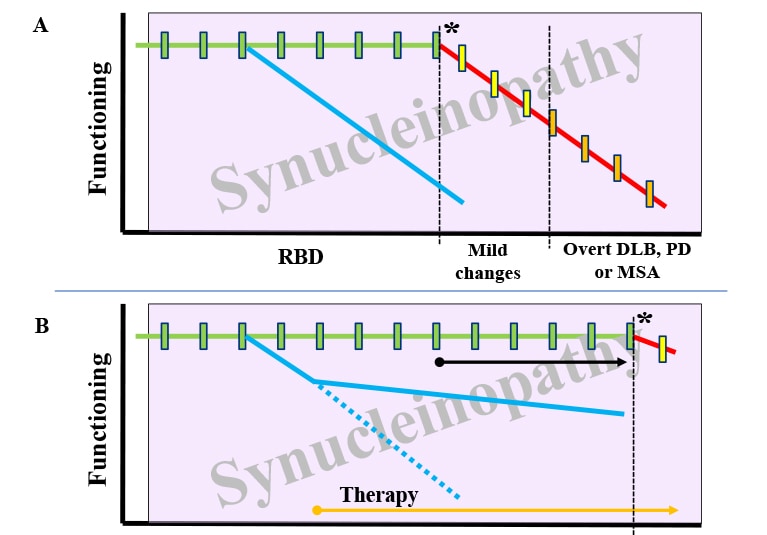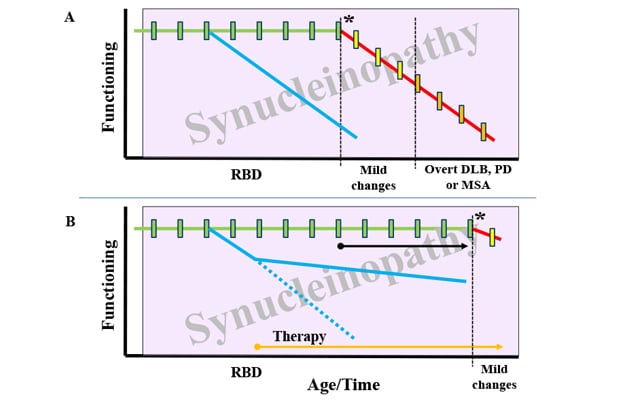Oct. 26, 2021

شرح التاريخ الطبيعي للتجارب السريرية المحتملة

شرح التاريخ الطبيعي للتجارب السريرية المحتملة
أ. يعرض المخطط جهود دراسة NAPS2 لفهم تغيرات السمات السريرية ونتائج العلامات الحيوية من أجل الاستعداد للتجارب السريرية المستقبلية التي ستُجرى على علاجات لتأخير خرف أجسام ليوي، ومرض باركنسون، والضمور الجهازي المتعدد أو الوقاية من الإصابة بهم. يشير رمز النجمة إلى حدوث تحول هائل من الوظائف الكلوية الطبيعية (الخط الأخضر) بين الأفراد الذين يواجهون اضطراب حركة العين السريعة السلوكي النومي وصولاً إلى تدهور متفاقم في الوظائف العصبية (الخط الأحمر). يمثل كل مستطيل تقييمًا شاملاً باستخدام مجموعة من القياسات السريرية وقياسات العلامات الحيوية التي تُجرى بانتظام. ويمثل الخط الأزرق علامة حيوية افتراضية تبدأ في التغير قبل سنوات من التحول الهائل. تواصل النتائج السريرية ونتائج العلامات الحيوية التغير بشكل خطي ومتدرج نسبيًا أثناء مرحلة البوادر الأولية. ب. يعرض المخطط الهدف النهائي. فإذا ظهر أن العلامات الحيوية تتغير بانتظام أثناء مرحلة البوادر الأولية، فيمكن تصميم التجارب السريرية لاختبار ما إذا كان أحد العلاجات (السهم البرتقالي) سيؤثر تأثيرًا إيجابيًا في واحدة أو أكثر من العلامات الحيوية (الخط الأزرق المعكوس)، ومن ثم فيحتمل أن يؤخر التحول الهائل إلى الإصابة بخرف أجسام ليوي أو مرض باركنسون أو الضمور الجهازي المتعدد أو الوقاية منهم. يشير السهم الأسود والخط الأخضر الممتد إلى استطالة مدة الوظائف العصبية الطبيعية.
Approximately 50% to 80% of people with isolated rapid eye movement (REM) sleep behavior disorder (RBD) will likely be diagnosed with an overt synucleinopathy within their lifetimes. Mayo Clinic is co-leading an international team of researchers working to identify biomarkers to predict that progression.
"Biomarkers can provide many insights since usually one or more are abnormal in individuals with RBD," says Bradley F. Boeve, M.D., a neurologist at Mayo Clinic in Rochester, Minnesota, and co-principal investigator of the study. "The trajectory of changes in those biomarkers will likely allow better predictions of which persons will develop an overt synucleinopathy, when the symptoms will develop and which specific disorder will evolve."
The international study — funded by an approximiately $35.1 million grant from the National Institutes of Health — aims to pave the way for clinical trials focused on stopping RBD from progressing to one of the overt synucleinopathies: dementia with Lewy bodies (DLB), Parkinson's disease (PD) or multiple system atrophy (MSA). The study's other lead researchers are from Washington University School of Medicine in St. Louis and The Neuro (Montreal Neurological Institute-Hospital) of McGill University.
The existing clinical and biomarker data on people with RBD is limited. Most of it comes from studies completed in single or a few centers over a short period of time.
"A comprehensive battery of measures and biomarkers from a multisite natural history study is critical," Dr. Boeve says. "Those measures and biomarkers could then be used to optimally design clinical trials to test whether any intervention is effective at delaying the onset or preventing the development of DLB, PD or MSA."
For more than two decades, Mayo Clinic has been at the forefront of research establishing the association of RBD with synucleinopathies. Not all individuals with a synucleinopathy have RBD. But the progression from isolated RBD to an overt neurodegenerative disease is well documented. The prodromal period can last from years to decades.
Participants in the international study will include members of the North American Prodromal Synucleinopathy (NAPS) Consortium, co-founded in 2018 by Dr. Boeve. Known as NAPS Stage 2 (NAPS2), the study will follow for five years approximately 430 participants with RBD and 60 people without sleep problems.
In a review published in the August 2021 issue of The Lancet Neurology, Dr. Boeve and colleagues from the International REM Sleep Behavior Disorder Study Group described 10 potential categories of biomarkers that have shown substantial promise.
Dr. Boeve notes that the greatest promise for predicting the evolution from RBD to an overt neurodegenerative disease will likely come from biomarkers that span multiple modalities.
"Some clinical findings or biomarkers — such as hyposmia and color discrimination problems — might appear early and change very slowly over time. Others — such as motor or cognitive impairment, or abnormalities on brain scans — might appear closer to phenoconversion," he says. "Ideally, we will find some combination of diagnostic biomarkers to identify the subtype of future synucleinopathy, prognostic biomarkers to inform proximity to phenoconversion and monitoring biomarkers to aid in tracking therapy response."
For more information
North American Prodromal Synucleinopathy (NAPS) Consortium.
Miglis MG, et al. Biomarkers of conversion to alpha-synucleinopathy in isolated rapid-eye-movement sleep behaviour disorder. The Lancet Neurology. 2021;20:671.